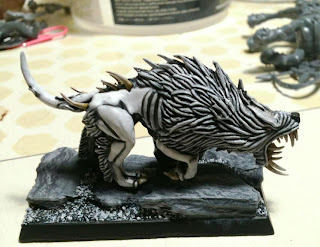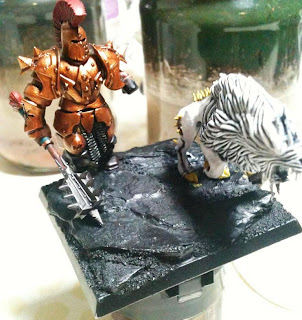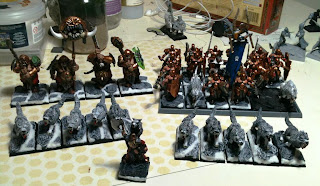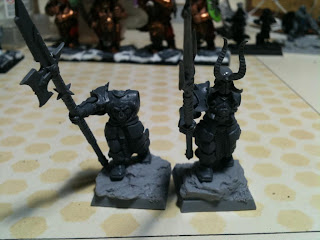So as it turns out, after my last fortnight’s mass-basing bonanza, I’ve pretty much run out of models that I can quickly base to gain some instant hobby progress. As a result, this fortnight has been a little more active in the fact that I actually had to put paint to model in order to maintain some semblance of hobby progress. For the most part I’ve been working on the final two unit fillers for my Chaos Warrior regiment which comprise of two wolves and my unit Champion. Between the two of these bases, they account for no less than 6 bodies in that regiment, which for my choice of formation counts for an entire rank. Understandably, this then gives completing these two models a sense of urgency when looking at the units’ progress as a whole. As can be seen in the pictures above and below, I’ve painted the wolves to resemble Tundra Wolves, a breed whose white coat provides them with a distinct advantage when hunting in the snowy plains and mountains. These contrast strongly with the Bronze and Flesh that features predominantly throughout the unit, hopefully drawing the eye to look closer at the army as a whole.
 |
| First Wolf Filler |
 |
| WIP Champion Filler Front |
 |
| WIP Champion Filler Back |
Throughout the painting process (for the wolves at least), I’ve made extensive use of my GW small dry-brush that I purchased from my friendly local game store (FLGS) late last week. It uses natural bristles to retain paint inside the brush and distribute it evenly across the raised areas of the model. Its unparalleled success prompted me to ponder the differences between synthetic and natural brushes and what makes one better than the other. For the most part, it could be argued that many painters are divided between two camps – those that use synthetic bristles for their brushes and those that choose to go all natural. While for many years I have been a strong supporter for synthetic brushes, I’ve developed a healthy respect for the abilities inherent of a natural brush and how they affect the quality of my paint jobs. For example: I’ve enjoyed the use of synthetic bristles for their ability to apply a smooth coating with comparatively little effort. However, I quickly discovered that they are not the best brush when it comes to dry-brushing or other texture work as the paint has difficulties remaining on the bristles while the excess is being wiped off. As a result, dry-brushing with a synthetic brush has an unfortunate habit of either over-brushing the area or becoming a glaze, washing the model, rather than applying a light dusting of paint to raised areas of detail. Alternatively, while the natural brushes’ ability to retain more paint is beneficial for dry-brushing, it has at times retained increased amounts of water also, making the paint much too thin, and causing it to pool rather than work as a basecoat. As a result, I’ve come to realise that there is a middle ground between these two camps – a no-mans land inhabited by those who cannot decide on which camp to join, if any. The fact is that both types of brushes are capable to achieving different effects and as such should be deployed accordingly. If you’re after a smooth coating, use the synthetic, if you want to dry-brush, use the natural.
As painters it is up to the individual to develop their own painting method that works for them, as everyone’s method is different. It may not be anything major that makes the style of two painters unique, but the differences are there and they must be acknowledged. To this end, I’m further exploring my own painting methods by using more natural bristled brushes. I’ve purchased additional GW brushes from my FLGS, keenly anticipating the different effects that may be achieved through using these brushes. The only downside I find is that GW’s price tag feels somewhat heavy-handed when you look at what you’re purchasing for your $8 - $14 AUD. But then again, you pay the price for quality don’t you?
On the Tournament front, I’ve been eagerly awaiting the release of the Players Pack for the Tricksters Blade event. From what I can wheedle out of the Tournament Organiser, the points limit for the tournament will be 2400, operating on a similar scale to the Ides of March Tournament held earlier this year in Brisbane. As a bonus though, many of the standard scenarios from the main Rulebook will be used, an improvement over the Pitched-Battle only present at Ides. Looking over my current army progress as seen below, I can confidently say that approximately half my army is assembled and painted depending on wargear choices, while the other half is either in the process of being built or is awaiting bits to arrive from various places in the US or the UK.
 |
| My WIP Chaos Army |
 |
| WIP Chosen |
With the first half of my army ready and waiting, I can focus on getting the remainder completed in good order. Considering my current play style, the remainder will most likely include a Chaos Lord, a unit of Chosen (concept miniatures shown above), a Warshrine (Thruug the Geriatric) and possibly some Chaos Knights (further remnants of my previous Chaos army). Hopefully that will leave me with enough points left over to buy some Slaaneshi Marauder Horseman with Flails. That said taking more units will require more painting and thus more time that I do not have. I have a very strong feeling that my remaining unit choices will not come from deciding what models are more competitive, but rather how much time they will take to paint. To be honest, these articles are a significant reason why my army is seeing steady progress as it allows me to maintain focus on a single facet of my hobby for an extended period of time. The results of this extended focus are reflected in my ever-improving stats which are as follows:
Number of Days until Trickster’s Blade: 43
Number of Units Completed: 5
Number of Points painted this fortnight: 96 (6 Warriors of Chaos)
See you all next time,
Trev






No comments:
Post a Comment